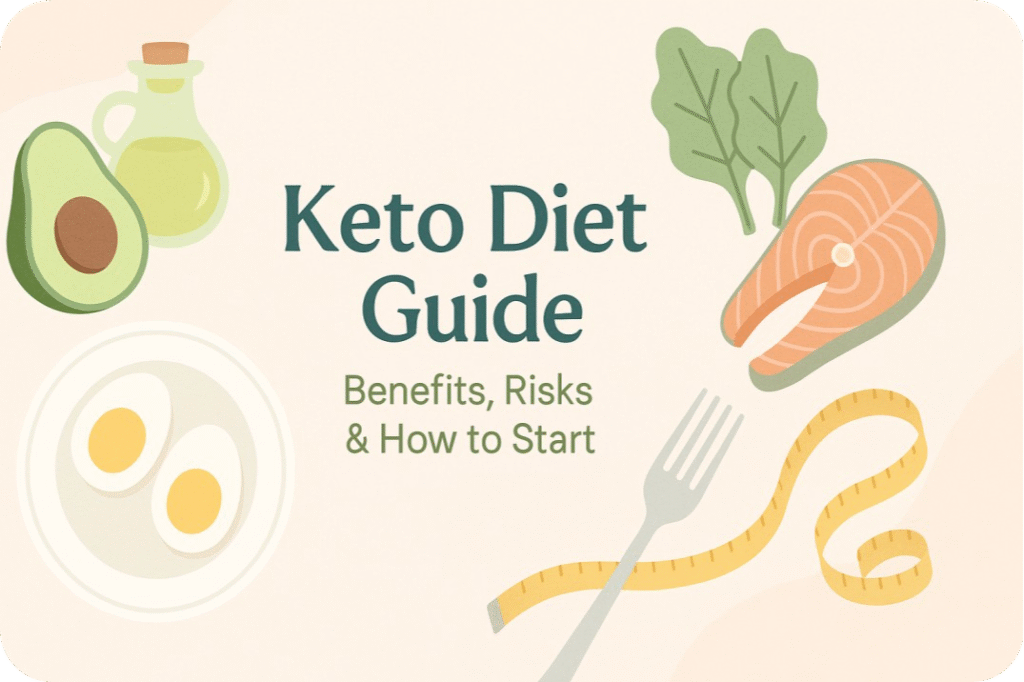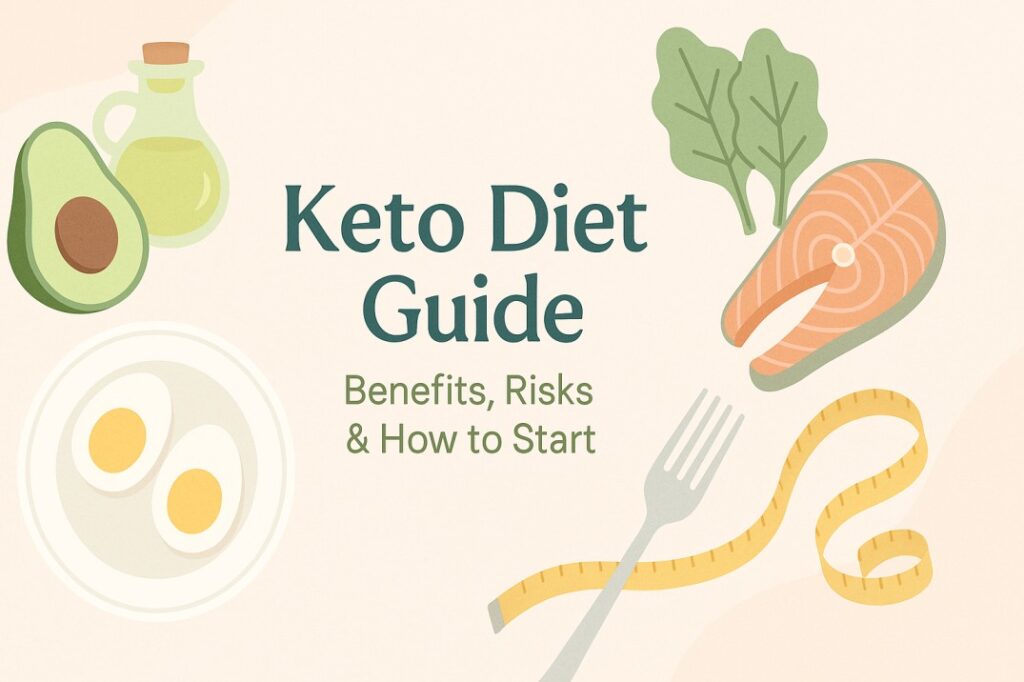The ketogenic diet or keto diet for short has exploded in popularity over the last few years. But beyond the buzzwords and Instagram transformations, what is keto really about? Is it just another low-carb fad, or a legitimate path to better health and sustainable weight loss?
In this in-depth guide, we’ll walk you through the science of keto, real-life benefits and challenges, what to eat (and avoid), and how to get started without feeling overwhelmed. Whether you’re new to keto or considering giving it another shot, this article is designed to answer your questions and help you make informed choices.

What Is the Keto Diet?
The ketogenic diet is a high-fat, very low-carb eating plan that aims to shift your body’s primary fuel source from carbohydrates to fat. This shift puts your body into a state called ketosis, where it begins producing ketones energy molecules made in the liver to fuel the brain, muscles, and other tissues.
Typically, a keto diet breaks down like this:
- 70–75% of calories from fat
- 20–25% from protein
- 5–10% from carbohydrates (usually 20–50g net carbs per day)
By drastically reducing carbs, your insulin levels drop and your body turns to fat dietary and stored for energy. This can lead to weight loss, more stable energy levels, and, for some, improved mental clarity.
How Keto Works: The Science Made Simple
Carbs are your body’s preferred energy source. When you eat them, your body breaks them down into glucose (sugar), and your pancreas releases insulin to shuttle that glucose into cells for energy. But when carbs are scarce, insulin levels fall, and your body starts breaking down fat into ketones for fuel.
This metabolic shift can lead to multiple benefits: your body burns fat more efficiently, appetite often decreases naturally, and some systems especially your brain may thrive on the clean, stable energy ketones provide.
Potential Benefits of the Keto Diet
Here’s what research and many keto followers have reported:
- Weight Loss: Keto can lead to rapid fat loss, particularly in the first few weeks as your body sheds water weight and burns fat stores.
- Appetite Control: Many people feel fuller with less food on keto due to increased fat and protein intake.
- Stable Energy: Without blood sugar spikes and crashes, energy feels smoother and more predictable throughout the day.
- Mental Clarity: Ketones may provide a more efficient fuel for the brain, leading to sharper focus and reduced brain fog.
- Improved Blood Sugar: Keto may help people with insulin resistance or type 2 diabetes by lowering blood glucose and improving insulin sensitivity (always speak with a doctor first).
- Reduced Triglycerides and Increased HDL: Some people see better cholesterol ratios on keto though this varies from person to person.
What You Can Eat on Keto
Keto is not just bacon and cheese (though those are often included). Here’s a breakdown of what’s typically on the menu:
✅ Keto-Friendly Foods
- Fatty meats (beef, lamb, pork, chicken thighs)
- Fish and seafood (especially salmon, sardines, mackerel)
- Eggs
- Non-starchy vegetables (leafy greens, broccoli, zucchini, peppers)
- Avocados
- Oils and fats (olive oil, butter, coconut oil, ghee)
- Full-fat dairy (cheese, cream, unsweetened yogurt)
- Nuts and seeds (macadamias, almonds, chia, flax)
🚫 Foods to Avoid
- Sugar (sodas, candy, desserts)
- Grains (bread, pasta, rice, oats, corn)
- Starchy vegetables (potatoes, carrots, peas)
- Fruit (except small amounts of berries)
- Beans and legumes
- Low-fat and processed foods
Side Effects and Challenges
Going keto is a big change, and it’s normal to feel some discomfort as your body adapts. Here are the most common side effects and how to manage them:
🌀 Keto Flu
In the first 3–5 days, you might experience headaches, fatigue, irritability, nausea, or brain fog. This is known as the “keto flu” and usually passes quickly.
Tip: Stay hydrated, add electrolytes (sodium, magnesium, potassium), and ease into keto gradually.
⚠️ Nutrient Deficiencies
If you restrict too many vegetables or whole foods, you may miss out on fiber, vitamins, and minerals. Make sure to eat a variety of keto-friendly plant foods and consider a multivitamin if needed.
🥱 Sustainability
Keto can feel restrictive over time. Social events, travel, or cravings might make it hard to stay consistent.
Solution: Consider cycling in and out of keto, or adopting a low-carb lifestyle that allows a bit more flexibility once you’ve reached your goals.
How Keto Compares to Other Low-Carb Diets
Atkins Diet: Also low-carb, but allows more carbs over time. Keto is stricter and aims to keep you in ketosis longer.
Paleo Diet: Focuses on whole foods and excludes grains and dairy, but doesn’t limit carbs as severely as keto.
Low-Carb/High-Protein: Keto is moderate in protein and high in fat. Some low-carb diets push protein higher, which can prevent ketosis.
Tips to Start the Keto Diet Successfully
- Track Your Macros: Use apps like Carb Manager or MyFitnessPal to stay within your carb limits.
- Meal Prep: Planning meals helps avoid last-minute temptations or hidden carbs.
- Stock Keto Staples: Eggs, meat, olive oil, cheese, nuts, and low-carb veggies make easy go-to meals.
- Stay Hydrated: Drink plenty of water and add electrolytes to prevent keto flu.
- Be Patient: Give your body at least 2–4 weeks to adjust before expecting major results.
- Talk to Your Doctor: Especially if you have a medical condition or take medications keto affects blood sugar and blood pressure.
Final Thoughts
The keto diet isn’t magic, but for many people, it’s a powerful way to lose weight, improve metabolic health, and gain energy and focus. Like any diet, success comes from consistency, proper nutrition, and understanding your own body.
If you’re considering keto, take it slow, stay informed, and don’t hesitate to tweak the plan to make it work for your lifestyle. Health is personal keto is just one of many tools that might help you feel your best.
Disclaimer: This article is for informational purposes only and does not constitute medical advice. Always consult a healthcare provider before starting a new diet or lifestyle change.
Further Reading: Healthline’s Keto Diet 101


